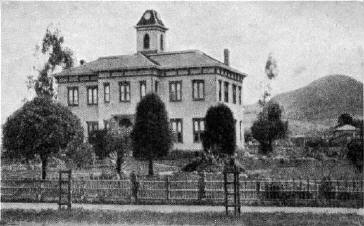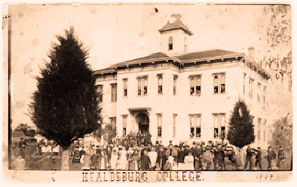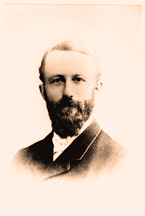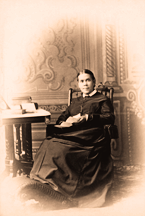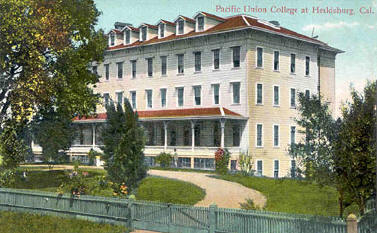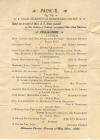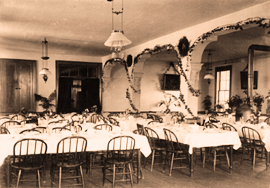The Schools
Schooling for Squatters: Unlike most other public institutions, the first schools did not develop in the commercial centers, the little towns and trading posts like Healdsburg that sprang up like weeds after the Gold Rush. It took only a handful of families to run those early 1850's towns. Typically they consisted of a general store, a blacksmith shop, a livery stable, and if you were lucky, a good saloon. The real centers of population in those early years were the fertile river valleys of the north Bay Area. Venturesome farming families and failed gold miners fairly stampeded into the Russian River Valley between 1850 and 1860. By mid-decade all the good lands had been "taken up", mostly by squatters. And those squatters begat many little squatters[1]. So it is not surprising that all three of the first School Commissioners who met to decide the fate of Mendocino Township schools in April 1854, were farmers. First, H.P. Mollison, Isaac Laymance, and William Kinkaid carved the township into two huge districts, each extending from the Russian River at Dry Creek all the way to the Coast. Their choice for the site of the first schoolhouse, two miles up Dry Creek, was not surprising either[2]. This coveted farmland in lower Dry Creek Valley was teaming with settlers and was later a hotbed of squatter rebellion. The exact location of that first township schoolhouse is not known. The meeting minutes in 1854 state that District No. 1 schoolhouse, 16 x 20 feet, was built "on Dry Creek at a place called the Narrows" about two miles above Heald's Store (which was near the current Plaza). That would place it near the site of the old Manzanita School, although that district was not formed until 1863. A man who attended that first school, and whose father helped to build it, Frank Sparks, placed the first schoolhouse a few hundred yards northeast of the Manzanita School in 1905. Apart from its location, Sparks' most vivid memory of his early school years in Healdsburg's pioneer schoolhouse was of the "lickings" he received at the hands of his teacher, apparently so severe that for many years he harbored the wish to return them in kind. District No. 2 schoolhouse was built soon after, about five miles from Healdsburg in another popular settlement area, along Westside Road between the H.P. Mollison and George Storey ranches[3]. This was known thereafter as the Mill Creek School.[4] The Mill Creek School actually opened first, in January 1855. The Dry Creek schoolhouse had its first term from May to August of that same year. Initially school terms were only three months long, then as the years went by, lengthened to five or six. School was in session only during the spring and summer months in rural areas because the roads became impassable in winter and boys and girls were needed on the family farm during fall harvest. Not only was the school year much shorter in the early days, and held in different seasons, but it was also unpredictable. Epidemics of cholera, measles, and other diseases raged through town in the 1800's, killing school age children. If a serious disease hit town the schools would close for fear of contagion. As ever more agriculturists poured into Dry Creek Valley, a third schoolhouse was built about six miles up Dry Creek Road near Lambert Bridge in 1857. This was later known as Lambert School, (now the site of 3001 Dry Creek Road.) Teachers at the rural schools during its first years include a Mr. Fitzgerald, R.j. Yancey, G.T. Espy, N. Eaton, E.L. Taner, R.A. Johnson, E.L. Green, B.N. Bonham, M.B. Harrison, a Mr. Willson, and William Byrd.[5]
Private Schools: The Russian River Institute It may be that the very first school was a small Sunday and day school established in 1853 by a Methodist congregation in Alexander Valley. It reportedly burned about 1863. Late in the year 1853 pioneer land grant owner, Cyrus Alexander, is said to have erected a small school which he called "Pine Grove" at his own expense, on his own land. His aim was probably to educate his own large brood, although others also attended.[6] By the late 1850's even the little village of Healdsburg was growing relatively populous. Educator Erastus A. Scott came to the newly christened town in the summer of 1857. Surveying the lack of educational facilities, he opened a private academy in January 1858.[7]
Scott commissioned a substantial two-story structure and named it the "Russian River Institute". It was built under the direction of Charlie Proctor in the midst of an oak and madrone grove, on land donated by Jesse Seaman just east of the town site. Construction was financed by $100 "scholarships" (subscriptions from prospective students) and generous donations from local mills, mechanics, and tradesmen. The dusty road that ran if front of the Institute was later named "University Street" in its honor. (now the site of 112 University). Pioneer W.A. Maxwell remembered the "housewarming" party in the new building in January 1858. Along with the requisite speeches came the loan of the only piano north of Santa Rosa at the time, which belonged to the Fitch family. Anita Fitch (later Anita Bailhache), then so young that her feet did not reach the pedals, was the first to play. Maxwell recalled, "...when Mrs. Bailhache sat down at the instrument and played one of those foot-inspiring pieces...it made men and women think how it used to be, "back in the States", and before the good Scott [who was opposed to dancing on religious grounds] knew what was going on, a whole floor of dancers were in full swing; just two or three quadrilles for auld lang syne, and then out of deference to the Professor they quit."[8]
In its first year Scott was aided by two teachers, Miss E.A. Downing, daughter of the local cabinetmaker, and Roderick Matheson, a distinguished local rancher who later became a Civil War hero. Other teachers that first year were E. Pelt, J.S. Miller, and Miss E. Allen. There was no lack of pupils that first year. There was a total of 103 students which included 46 ladies and 57 gentlemen, two San Franciscans, one Petaluman, and one Santa Rosan. But funds were scarce as most of the subscriptions had been used for construction. Agricultural and Mechanical University of CaliforniaIn 1859 a group of local citizens headed by Matheson took over the school. It was then christened with a distinguished name, the Agricultural and Mechanical University of California. These men had great ambitions for the school, envisioning a mechanical shop, a mill, student worked corn and hemp fields, and botanical gardens. Matheson and another board member, Charles E. Hutton, had even secured the use of a printing press owned by local citizen, J.B. Boggs, and had gathered $400 in local subscriptions to support a newspaper to be published by the college. In exchange for clearing his land, Matheson offered some nearby acreage for agricultural training.[9] Yet they were beset by financial problems in their ambitious endeavor. Individual board members "invested" more and more of their own money to keep the school in operation. Still, the idealist Matheson wrote a strong letter to the board on Sept. 7, 1860: "...All institutions of a literary and scientific character, that have any prominence in the world, unless endowed by the dying millionaire or royal bequest, have had, in their infancy to struggle for very existence; and had there been at the head of their affairs, a weak, vacillating and timid Board of Directors, they must have perished ingloriously, and have sunk into obscurity..."[10] Only four months after firing off this letter, Matheson was called away to Washington D.C. to attend the inauguration of President Lincoln. He never returned to Healdsburg, for as the Civil War opened, he answered Lincoln's call to become the first Colonel of the First California Regiment. He died of his wounds on October 2, 1862.[11] First Literary Society and LibraryFinancial problems only worsened in the months following Matheson's departure, and the great University that he and his fellow board members envisioned did perish rather ingloriously. It closed and reopened under a series of administrations and headmasters between 1861 and 1867. One of these, a Professor Anderson, has the distinction of having created the first literary society in Healdsburg, as well as a pioneer 300 volume library that was later absorbed into the public library. During these years the school was known as the Sotoyome Institute, but when it later fell into the hands of Cyrus Alexander, who conveyed it to the Presbyterian Church, it became the Alexander Academy.[12] Finally the beleaguered University/Institute/Academy was taken over by Dr. S.H. Thomson in 1877. Using his own family as faculty, Thomson built a large and impressive new building at the end of Plaza Street for the new school, now known as the Healdsburg Institute, in the fall of that year. [13] Newspaper reports seem to indicate that the old Alexander Academy on University Street continued to operate for a short time even after Dr. Thomson moved to the new building, but the Healdsburg Institute absorbed its faculty by late 1879.[14] A year or two later two young women, a Miss Carter and Clara Heald, opened a private seminary there (known locally as the "kindergarten") that operated until at least 1883. That was its last use.[15] The abandoned pioneer "University" building, now vacant, was soon was taken over by bats, yellow jackets, and the occasional band of local children. The bravest of these last might climb the rickety old stairs to the unused belfry. In 1886 a deacon of the Presbyterian Church, a Mr. Gates, purchased the old school and lot for back taxes, demolished the old building and subdivided for residences.[16]
A Public School for Healdsburg Although the Russian River Institute was available to those who could afford tuition, by the late 1850's Healdsburg citizens realized that it was time to bite the bullet and raise subscriptions for a proper public schoolhouse right in town. Harmon Heald donated a plot for the "District of Common Schools" when he laid out the town in 1857. According to one account the first schoolhouse was a small redwood shack of about 18 x 24 feet that stood in a little grove of manzanita trees near the southwest corner of East and Tucker Streets. Mrs. H.W. Dickenson, one of the first teachers, also organized a Sunday School here. When the Russian River Academy opened in 1858 this school was reportedly closed and the Sunday school moved to the academy, now named "Little Pilgrim Sunday School".[17] It was not until January 1859, that construction started on a new school building located somewhere on the block bounded by Tucker, East, Matheson, and Fitch Streets (now the site of St. John's School).[18] No photographs have survived to show which street that 1859 schoolhouse fronted or what it looked like, but the two larger public school buildings that replaced it in 1871 and 1877 faced Tucker and East Streets. The grammar school remained on this site until it moved to its current location in 1936. This site also doubled as the location of the first Healdsburg High School when the upper floor of the grammar school was taken over in 1888 to serve the purposes of "higher" education. Before that time local youths had to board in other nearby cities to attend public high school. Those who could not afford such a luxury went without. In September, 1888, Professor H.R. Bull opened his high school "department" with fifteen eager students in attendance, ready to embark on a three year program. By August 1890 increased enrollment warranted the building of a new building next to the grammar school. This spared upper classmen the humiliation of sharing a room with the first graders, which space limitations had by this time made necessary. When the high school won accreditation by the University of California on its first application in June 1893, the local papers proclaimed, "Hurrah for the High School!"[19] The first high school graduation exercises took place in June 1891 when proud townsfolk packed Truitt's Theater to watch nine successful scholars (eight young ladies and one courageous gentleman) receive their diplomas. Over the rostrum hung a banner that read "Schoolhouses are the Nation's Line of Fortification." As the very first crop of Healdsburg High School students, they are noted by name: Anna Amesbury, Junia Cook, Olleva Dutton, Julius Fried, Leonora Gates, Carrie Moulton, Margaret Powell, Edith Soules, and Adelaide Stites.[20] Healdsburg College Unlike many other small towns in Sonoma County, Healdsburg could offer those high school graduates the option of a college education. After the private Healdsburg Institute failed financially in 1881, the Seventh-day Adventist Church purchased the four-year old building. For a quarter of a century thereafter they ran it as Healdsburg College.
The Seventh-day Adventist Church first began organized work in the West in 1868 when D.T. Bourdeau and J.N. Loughborough arrived in San Francisco. Since that time church membership in the Golden State had grown. Although the "capital" of Adventist education was in Battle Creek, Michigan, many Californian Adventists felt that this was too far to send their boys and girls. Yet without a church school, parents feared that their sons and daughters might "drift away from the Message."[21] Part of that Message was conveyed by church prophetess, Ellen G. White, who urged the membership in 1881 to found a western school. Her son, William C. White, soon departed for the East to retain the services of Professor Sidney Brownsberger as principal.
Brownsberger, a bright graduate of the University of Michigan, had run afoul of radicals in the congregation who believed that the new "Spirit of Prophecy" called for more practical ideals in education (at the expense of classical training). Most church members at the time even opposed school dormitories as "fostering evil influences."[22] Weakened physically by the dispute, Brownsberger had resigned as president of the Battle Creek institution the year before. He was therefore free to accept W.C. White's proposition. Open To All Denominations Church officials investigated several school sites in Sonoma and Napa Counties where Adventism had taken root, including Napa, St. Helena, Santa Rosa, Petaluma, and Healdsburg. But when the small town of Healdsburg hosted an Adventist conference in January 1882, church members there urged the selection of that site. Healdsburg Adventists argued: "Property could be obtained cheaply, the climate is good, crops were certain, and the people were prosperous."[23] Adding convenience to their argument was the fact that Dr. Thomson's Healdsburg Institute was available for sale. An impressive Italianate two-story structure built in 1877, the Institute had nevertheless failed financially due to lack of enrollment in 1881. The free public school on Tucker Street, by then firmly established, had drawn away too many students from the venerable academy.[24] Although valued at $10,000, the Adventist Church bought the school property from Mrs. Mercy Gray for $3,750 on April 5, 1882. She had recently purchased it from Professor Thomson for a proposed Baptist college that never materialized. Enrollment at the Adventist-run school, first known as the Healdsburg Academy, was open to all denominations. The citizens of the town of Healdsburg were always proud of the school's presence in the community. The editor of the Russian River Flag assured readers that this would not be "a proselytizing school but is to be conducted in such a manner as to attract all young gentlemen and ladies who desire a more advanced education." He hoped that the school would attract many "new and desirable" residents to Healdsburg.[25] It was, in fact, prestige-conscious Healdsburg citizens who persuaded church officials (who had some misgivings) to change the name from the more homely "Healdsburg Academy" to the grander "Healdsburg College." Healdsburg College opened on April 11, 1882, with 26 homesick scholars who felt dwarfed by the commodious building with six classrooms, principal's office, bookstore, hall, library, and assembly room.[26] Professor Brownsberger began that first school day with the singing of "Home Sweet Home", and we might imagine those tremulous, tear-strained voices as they echoed off the empty walls. By the end of its first full term the college had a faculty of six, including Professor Brownsberger and his wife, W.C. Grainger and his wife, Edith Donaldson, and Mr. and Mrs. C.C. Ramsey. There was a total of 152 students enrolled. Prophetess of God
Mrs. Ellen G. White, an early proponent of the college, had taken up residence in Healdsburg to be near the new school. Born in Maine in 1827, White was considered by her church to be a prophetess of God and reportedly wrote many of her best-selling religious books in Healdsburg. Her one time home still stands at 201 Powell Street in Healdsburg, as well as her ranch home at 1950 West Dry Creek Road. While retaining Healdsburg as a base until 1908, she traveled worldwide spreading the Message of the church. She reportedly called Healdsburg a "beautiful, beautiful place."[27] Ellen G. White was also instrumental in the additional purchase of a five acre tract on Fitch Street that later became the Healdsburg College dormitory (now the site of Healdsburg Junior High School). This was the first such "School Home" in any Adventist institution, and given the aforementioned mistrust of such facilities by many church members, it was also a definite victory for Professor Brownsberger.
Although church officials warned that they might be depleting other small Adventist congregations, members continued to move to Healdsburg to be near the school and their children. Already a strong influence in the little town, Seventh-day Adventists eventually made up a fifth of Healdsburg's population. In keeping with the beliefs of the Seventh-day Adventist Church, there was a strong vocational slant to the curriculum of the college. In addition to the basic courses offered in Bible study, history, languages, natural sciences, and mathematics, there was an entire "Industrial Department" offering classes in broom-making, painting, cooking, dress and tent-making, carpentry, blacksmithing, agriculture, and even plumbing. When the first female students were put to work in the laundry at the inception of the first school year, Professor Brownsberger noted that they did not shirk. He reportedly cried in response, "We have made a beginning. We have won the victory. The labor by students is not despised, but it will be a glory and an honor wherever they take part."[28] The first school bulletin stated that education was to be seen as an "improvement of the Powers of the entire human organism," fostering "a commendable self-sufficiency" with the result of "a more profitable class of citizens." Toward this end, students were required to perform two and a half hours of manual labor daily. Students accomplished many of the improvements at the school, as well as many of the day-to-day maintenance tasks. Stand Still, Walk Backward, or Run AwayFrom its founding the college was also co-educational. Although Adventists prized education for their daughters, and often honored women with positions of high prestige in the church, the curriculum for women at Healdsburg College differed greatly from that offered the young men. Young ladies were offered courses more in keeping with their limited future roles including classes in "healthful cooking" and "useful employment" (laundering, dressmaking, etc.) Despite the desire of Adventists to educate their daughters, "village students" (non-Adventist Healdsburg residents) made up most of the female enrollment at the college. The relatively expensive proposition of sending girls away to school, when one or more sons might already be attending, discouraged many Adventist families from taking advantage of the college.
Throughout its history Healdsburg College, like most private colleges of its era, retained a strong moral and religious flavor. During its first term of 1882-1883 a pamphlet warned that "all students must refrain from flirtation, courtship, and all appearance of same." As students walked from the dormitory on Fitch Street to the classroom buildings at the end of Plaza Street, the ladies used one side of the street while the gentlemen used the other.[29] We can only guess at the very meaningful glances that must have daily simmered across Fitch Street during this era. When being scolded for allowing a gentleman to walk beside her to school, legend has it that one young lady lamented, "What could I do?" Replied a faculty member, "Stand still, walk backward, or run away from him!"[30]
At the School Home young men and women occupied different floors, and when caught in an unauthorized association, they were compelled to make a public confession in chapel as a penance. One girl caught fraternizing without permission reportedly confessed honestly, "I'm sorry I was caught. I won't be caught again."[31] The Adventist religion placed a high priority on a healthy diet. Far ahead of its time, Healdsburg College had a "health food store" on campus. The School Home dining room introduced a vegetarian diet in 1895.
Step-and-a-Half GraingerIn the summer of 1886 "unfortunate complications in Brownsberger's personal affairs" led to his withdrawal as president.[32] The post was taken over by W.C. Grainger, who is credited with presiding over the glory days of the college (1886-1894). Grainger, who came west after a grasshopper plague in his native Missouri, first taught school in Ukiah and Anderson Valley, California. Persuaded by his neighbor, Abram La Rue, he converted to Adventism in Anderson Valley. A tall, Lincolnesque man, President Grainger reportedly had a dry sort of wit. An old injury caused him to limp, which led to the affectionate student nickname "Step-and-a-Half Grainger." Teachers and students seemed to appreciate his encyclopedic knowledge and kindly, helpful, and very informal manner. This informal manner, however, eventually led to his downfall. Straight-laced church officials visiting from the East criticized Grainger's college as scandalously informal. Boys entered the dormitory in their boots; friendly students and teachers invaded Grainger’s office at all hours without any restriction. Realizing that church officials desired it, President Grainger resigned in 1894. He went on to do important missionary work in Japan, dying there in 1899. The home he lived in during his Healdsburg years ,moved from the location of the Healdsburg College campus, is still standing at 219 Piper Street.[33] The Devil Sowed Houses Although Healdsburg College was for many years a financially sound institution, especially under President Grainger, it suffered severe financial deficits at the turn of the Century. In 1905 Healdsburg College president, W.E. Howell, blamed such financial straits on "unwise borrowing for expanding industries, some 'not essential' to the work of the college."[34] There was also the problem of the growing town of Healdsburg. When first established, college founders had been looking for a rural setting. Now, as the town of Healdsburg continued to grow all around the school, the classroom buildings at the end of Plaza Street had become separated from the School Home on Fitch Street. Having neglected to buy farm acreage between its facilities, Healdsburg College was now made up of two islands surrounded by many new homes. As Ellen G. White put it, "While men slept, the devil sowed houses."[35] The College limped on for a couple of years, then saw its final campus activity, in the old dormitory, on July 14, 1908. The college classroom building itself had been sold a year before to a group of Healdsburg citizens, who leased it to the local school board for use as Healdsburg High School. These beneficent citizens, including Eli Bush, held the property until the City of Healdsburg could afford to buy it for $5,500 in November 1915.[36] Eventually a new Adventist school, Pacific Union College, opened in Angwin, California in 1909.
The Rural Schools As the population of Sonoma County grew, the large school districts were carved up into ever smaller ones. We can watch that population rise and fall by charting the number of schools. In 1852 there were 5 private schools reported on the old Mexican ranchos. By 1854, the year Healdsburg opened its first public school, there were 23 schools in Sonoma County. In 1876, the tail end of the settlement era, there were 138 primary schools. That number rose only slightly in the next half century, to 141 in 1925, and actually fell to 122 grammar schools in 1937, during the Great Depression.[37] Numbers may help historians, but they certainly fail to give the flavor of the old one-room schoolhouses that dotted the countryside. It is said that school officials placed them about four miles apart so that no child had to walk more than two miles to school. They resembled a small farmhouse, redwood covered with clapboard, with a small front porch. They usually had two distinctive features: two front doors, side by side, one for the girls and one for the boys, and a belfry with a school bell on the roof. Out back stood a woodshed and a pair of two-seater outhouses, also segregated by sex. Some of the outhouses were insect and snake infested, but some also had a Sears Roebuck catalog for reading, wishful thinking, and practical use. Inside, blackboards covered the schoolhouse walls. These were well used due to a scarcity of paper. A wood stove, desks, clock, flag, and maybe a piano topped off the decor. Those desks were filled with a motley crew of often barefoot scholars, sometimes accompanied by their pet dogs. They ranged in age from six to about 15, but some could be as old as 21.[38] |
|||||||||||||||||||||||||||||||||||||||||||||
